July 2002
Here Today, Gone Tomorrow
Michigan, Ontario, New York, Vermont
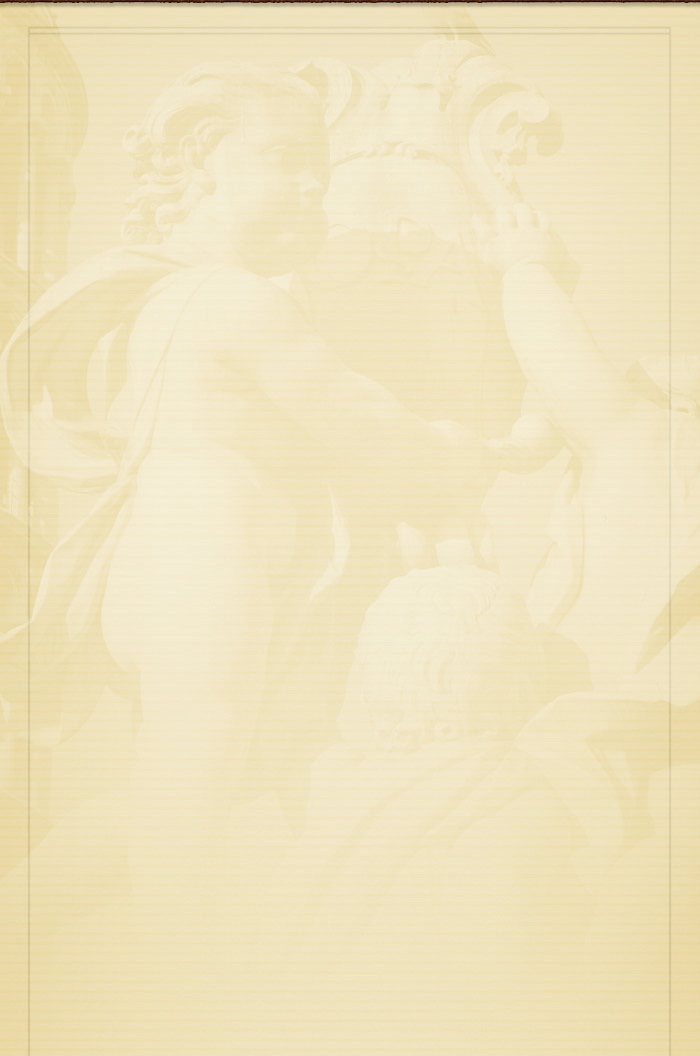



July 2002
Here Today, Gone Tomorrow
Michigan, Ontario, New York, Vermont
Or… Ontario Province now, the Maritimes soon, and three states in between. Say hello to the nice Customs man, Jeremy and Agnes
One immediate rush we get every time we send out a message to all of you is that so many of you write back. You share in our fun times, and also make contributions about your own travels in the areas we are visiting. This truly adds to our experiences. Consider our comments about our trip to Niagara Falls; we got word back from some of you about your own trips there, many years ago, and a much wilder, wooly-er time that was! Phyllis Roberts and Kris Dermott: you two are a couple of wild and crazy ladies! Intrepid travelers, both.
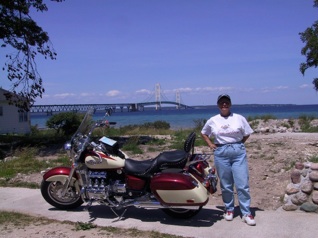
Our first layover after getting into the UP was in a township (read: municipal) park along the Fox River. Quite pretty, and we had the pleasure of being joined by a group of canoe-ists (canoe-ers?) as they collapsed for the night before heading on down the river the next day. It was a group of about 15 people, part of an organized tour, and when they arrived there was a huge mound of pizza boxes waiting for them. We drooled, as we ate our relatively mundane dinner. But paddling is hard work, and they both collapsed early and headed out groaning the next morning. The Fox goes south and dumps into Lake Michigan, which presumably was the end of their trip. We promised ourselves we would join such a group one day and try it for ourselves.
The UP is filled with small community parks that are set up for camping as well as picnicking; they are mostly used by Michiganders, apparently, as we’ve seen very few out-of-state plates. The electricity can be a little spotty, and there aren’t a lot of amenities, but we have found them delightful. And we finally figured out that the reason why everybody has fires going in the evenings, smudge fires really, because they are mostly smoke, is to keep the mosquitoes down. THEY ARE WHOPPERS! And the flies are huge too.
After leaving Seney and the Fox River, we moved further northwest, traveling through Marquette, where we stopped at the local maritime museum. Again, a bit fusty and funky, but fun. Also informative; much of the material was devoted to the shipping industry and ship wrecks. Lake Superior (Marquette is along the shoreline) is known for doing in the ships that carry materials around the lakes. As Californians, we have paid little attention to how products move in the rest of the country. Great lake shipping was, of course, a major factor in the development of huge parts of the country, and in providing the materials for wars and construction for over a century. We found that most of the lumber that rebuilt Chicago after the fire that destroyed the city (remember Mrs. O’Leary’s cow?) came from the Upper Peninsula. It was brought down to Chicago by barge, naturally. Of note to those of you who are lighthouse aficionados: the Marquette museum has 3 Fresnel lenses; more than we’ve seen in any one place before. And are they lovely!
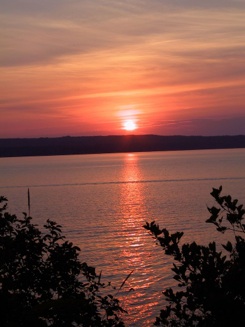
Michigan sightings: Da Yoopers Tourist Trap outside Negaunee; they say they have EVERYTHING you could possibly want. No entrance fee! (Yooper seems to be the local interpretation of UP.) And people have names for their homesteads: Rancho Relaxo; Oleo Acres – the Cheaper Spread, Shangri-Lodge (this in a skiing area). Oh yes, and U.P. Chuck’s (a bar and restaurant, evidently). And you can buy sweetgrass for $5.00. What’s sweetgrass?
The further north you get, the more flowers you see: on city streets, in front of people’s houses, hanging in baskets from light stands. People who live where there are cold, dark winters want light and color when they can have it. Petunias mostly; and delphiniums right now. Truly beautiful. You also see more and more logging trucks. There is plenty of logging going on here; what interested us was that the logs are shorter than in the Sierras. In California, they lay the length of the truck, and there are probably 4-6 per vehicle. Here, they are much smaller, run the width of the truck bed, and there are probably 30-40 per truck. The trucks are “downbound”; isn’t that a great word!
The Upper Peninsula is too remote for us to want to stay here long, but it’s great to visit. The countryside is mostly green and lovely, with roads going along the lakes and streams. Unfortunately, many of the roads continue to bolster Michigan’s hard earned reputation as the bad road capital of the nation – at least so far in our travels. Rick came up with the following: What’s the prime rule for driving in Michigan? If you find a good road, stay on it! But, the wildflowers are abundant (in July!) and the berries are beginning to ripen. The locals all talk like they were in the movie “Fargo,” and the waitresses (I refuse to use the word “waitperson”) say “youse”, as in “Can I get youse anything more?” and “How are youse all today?” All is joyous; we awaken each morning to the sensation of our mosquito bites saying hello.
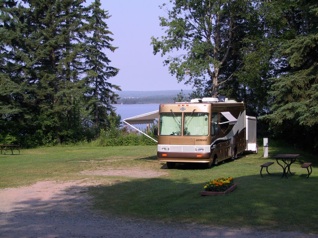
Before leaving the western UP, we took a ride almost to the Wisconsin border, traveling through the “Mid-West skiing capital”; there were gondola rides up to the top of the “slopes,” ski chalets, the whole works. I guess when you’re in an area that gets all that snow every year, it doesn’t take much of a hill to make for good skiing. Almost touching Wisconsin reminded me that when you get close to state borders, the lines often blur between what’s usual in one state vs. what’s usual in another. Very western Michigan looks a lot like Wisconsin: rolling hills, farming, barns and farmhouses, etc. You leave rustic, undeveloped UP behind.
I’ve forgotten to tell you that Rick thinks he’s died and gone to heaven. Michigan is full of Big Boy restaurants. Those of you from southern California will recognize this as the same as Bob’s Big Boy Restaurants. Same double burger, fries and chocolate malt. Never having thought this mattered when in California, I can’t get too crazy about them here. Rick burbles with joy whenever the subject comes up. Those of us from north of Santa Barbara (the Mason-Dixon line when I was growing up) eschew anything that comes from “the Southland…..”
And then, and then…….what do you think we saw? Oh, I’ve gone to heaven, too! We’ve now moved on, further east, heading toward Sault Ste. Marie and Canada, and have found a Hudson’s Restaurant! Chicken soft tacos, great hamburgers, chicken Caesar salad; all the good stuff! Tootsie pops, too. Hudson’s has now franchised itself out of California, and we were told there are several in Michigan, Wisconsin, Texas, and the southwest. How about that! We used to eat at Hudson’s about once a week in SLO. Too cool.
Before Canada, we made a stop in Whitefish, the northeasterly-most spot in Michigan; along Lake Superior. Very quiet and remote, and containing a lighthouse and shipwreak museum that is a real jewel. This spot is well worth checking out. It’s a small museum but “choice,” as Spencer Tracy used to say about Katherine Hepburn. (Actually, he pronounced it “cherce,” I believe; it’s from the movie “Pat and Mike, I think.) anyway…….I’m so good at digressing. We really enjoyed our visit to the museum, the lightkeeper’s cottage, etc. A great spot.
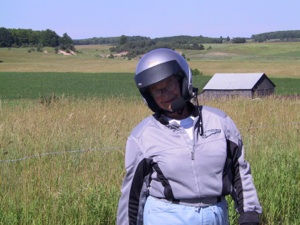
We have really enjoyed our first real sojourn into Canada (Ontario Province). Listening to the CBC is a treat. There are great programs and great music. We did, however, have to change the station once: the program coming on was a call in show on the topic “Who Taught you to Canoe?” We turned thumbs down on that!
Blueberries are just coming on; also raspberries and some corn (who woulda thunk it?) and wildflowers everywhere. One particularly beautiful flower is a bright purple spike. Very lovely, but evidently it’s a terrible weed that’s choking out everything in the marshy areas and clogging up the rivers. Not our problem, for once. We spent one night camping in a charming provincial park; the only real difference we noticed was they asked us if we wanted “hydro”; it turns out that means electricity! More adventure: leaving the park, we knew we were low on fuel, but thought we’d be heading towards an urban area and could remedy the problem then. NOT A CHANCE! The road took a turn for the rural, and off we went, keeping our fingers crossed. Twas a lovely road, indeed, with rolling hills and beautiful lakes lined with cottages, but nary a pump in sight. ‘Arvey started to cough; Kathy started calculating the distance back to the nearest town; Rick eased off on the pedal, turned the next corner, and we floated into a Shell station. Heavy sighs of relief all around (except the cats; still asleep). We filled up, and headed on down the road to our destination, a visit with our friends Dave and Ann Bernhardt, from San Luis Obispo. They had rented a house on a splendid lake that they had been visiting for years (Dave since childhood). We spent two grand days with them, including a ride on the lake (Lake Catchacoma) and a trip into Peterborough for dinner because all the electricity was off for about a zillion miles (hectares?). This turned out to be a real treat, as the restaurant we happened on to with no prior knowledge was outstanding.
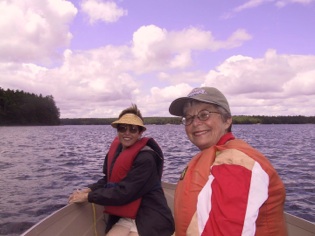
Since leaving Canada, we’ve faced eastward, heading toward Nova Scotia. We rode through the Adirondacks of New York, always a beautiful trip. Our route took us through Lake Placid, with an Ironman Triathlon about to take place; the joint was mobbed. We were happy to just get out of town in one piece! Then over a lovely, low, friendly bridge across Lake Champlain and into Vermont, an incredibly lovely state. Have you ever been in Vermont? If not, run, do not walk, and go there immediately. The entire state is beautiful, and we really enjoyed ourselves. Within a 100-miles we had the opportunity to stop at a working cider mill, Ben & Jerry’s ice cream headquarters, Cabot creamery, and a working grist mill. What more could you want? Ben and Jerry’s was fun. We had been there in 1994, and surprisingly the place looks just like it did then. Very low key, with cows around, places to park in the gravel, no tour because it was a weekend (but a video instead), loudspeaker music from 20-25 years ago, a display about “Compost Happens”, very hippie and fun. And, of course, all the ice cream you could ever want to buy.
We spent a fair amount of time comparing New York and Vermont. They are both lovely states, but we found New York to be somewhat cleaner. Vermont still allows a lot of trailers parked beside the road, often with several junk cars parked in front. On the other hand, we drove through Stowe, a lovely skiing town, and were struck by the difference between it and Lake Placid. Stowe is very low key (see above). We realize that all the activity in Lake Placid was unusual, but nonetheless, if we were picking a place to go skiing during the winter, it would be Stowe. So there! We also went through two other beautiful little Vermont towns: St. Johnsbury and Waterbury. As pretty as we have seen anywhere, and there are tons of lovely villages in New York.
Our route very quickly crossed Vermont, and even more quickly passed through New Hampshire, also very lush and green, with plenty of hills (they call them mountains) to enjoy. And the wildflowers are just to die for. A wonderful variety of colors, and usually three or more varieties blooming at once along the highway at any given point. Vermont has the Passumpsic Bank; New Hampshire the Siwooganoc Bank. Would you put YOUR money in a bank whose name you couldn’t pronounce? New Hampshire also has signs saying “Brake for Moose: It could save your life. HUNDREDS of Collisions.” And somewhere we saw a highway sign at the top of a steep grade saying “Sortie D’urgence Pour Camions;” this is French for runaway truck lane. Got that covered!
But on to Maine. As we write this, we are planning to go through Bangor and on to the coast; our route will take us to the Bay of Fundy and New Brunswick. We do not expect to be able to send messages while we are in the Maritime Provinces, and hope to get this off before we leave the States. So this will probably be our last communication with you until after Labor Day. Enjoy your summer as much we are enjoying ours. Every day of the year is “summer” for us. Rick says he feels as if “we are in a perpetual state of grace.” Kathy, who tends to have a different take on things, says she’s “waiting for the other shoe to drop.” In any case, we are happy as could be, and hope you are as well.
Bye.
See more photos from 2002-2003

